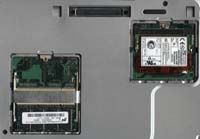Compaq Presario 2800 Pentium 4-M 1.7GHz Notebook
by Matthew Witheiler on May 10, 2002 12:18 AM EST- Posted in
- Laptops
The left side of the Presario 2800T is home to the "hot swappable multibay" port which can accept any number of Compaq removable drives and batteries. In the case of our Presario 2800T, the bay was populated with a 8X DVD/CD-RW (8X8X24) combo drive. The drive slid out easily using the release on the bottom of the notebook. To the left of the DVD/CD-RW drive is a single PCMCIA slot capable of accepting one type II PCMCIA card. The system only has room for one PCMCIA slot because the system's height, at 1.3 inches, does not provide the space necessary for two stacked slots. Finally, on the back of the left-hand side, are two 3.8mm audio jacks, one for headphones and one for an external microphone.
The back of the system is home to a collection of ports. The first port on the far back right of the Presario 2800T is the AC power-in port. Moving one over from the power input is the internal ethernet jack followed by the internal modem jack. The next five ports are covered via a plastic cover that folds down when the ports are in use. The plastic cover keeps dust out and provides a slick look for the system when being carried around. Opening up the cover reveals two USB 2.0 ports on the right of the system. The ports are stacked horizontally, not vertically and provide a 480Mbps connection to USB 2.0 peripherals. Next to the USB ports is a single PS/2 port used for an external keyboard or mouse. To the left of the PS/2 port is a 15-pin VGA port and a standard parallel port. Past the parallel port and outside of the covered area lies an IR port as well as an CPU fan intake.
The back right side of the Presario 2800T is home to a Kingston lock port as well as the exhaust for the CPU fan. Exhaust temperatures out of this vent reached a quite toasty 156 degrees Fahrenheit (68.9 degrees Celsius). To the left of the exhaust port is the hard drive cover which can be removed by unscrewing a screw on the bottom of the system and sliding the whole unit out. Finally, to the left of the hard drive is the battery, removed by sliding a lever on the bottom of the system.
The bottom of the system holds two access panels. The removing the screw holding the panel on the left on gives access to two expansion memory slots. Of the two SODIMM expansion slots, one is populated with the base memory which in our case was 256MB. In this configuration there remained one expansion slot open that was capable of accepting additional PC2100 266MHz DDR SDRAM.
The other access panel, the one on the right of the system, provided access to the system's integrated 56Kbs modem. The modem is actually mounted on a removable card that fits in a socket similar to a memory socket. Although this should provide for easy modem upgrades in the future, the likelihood of modem technology advancing much farther than it has today is highly unlikely, strongly reducing the need to upgrade or replace the 56Kbs modem in the future. The modem is likely implemented in this way not to facilitate end user upgradablity but to make it easier for Compaq to replace broken modems and use the same modem card across a whole line of notebooks.
The hottest part of the notebook's bottom was found to the left of the system's intake fan. Temperatures here measured 124.5 degrees Fahrenheit (51.4 degrees Celsius).
One interesting part of the Presario 2800T is actually located on top of the system. It is here, on the back of the LCD panel, that one finds the Compaq MultiPort module. The MultiPort is intended to provide wireless connectivity to the Presario 2800T by mounting the radio and antenna at a convenient and effective location on the system. Out of the box the system comes with a plastic cover over the MultiPort module, but the cover is removed with a simple slide and MultiPort options are easily added on. The current options are an 802.11b wireless network module and a Bluetooth module, both of which are easily snapped onto the top of the laptop. It seems that the MultiPort solution would prove to be a good one for wireless applications, especially considering that the majority of PCMCIA wireless solutions use damage prone external antennas. Plus, the MultiPort module places the antenna in a location that seems to be more apt to receiving radio signals.
 |
As mentioned before, the Compaq Presario 2800T is fits more of a thin and light notebook form factor than a desktop replacement form factor. The system measured 1.3"x12.48"x10.1" and weighed 5.7 pounds with the battery which made it easy on the back.












0 Comments
View All Comments